Dinger's Aviation Pages
The Sinking of the Königsberg.
I am indebted to Torstein Saksvik, Ketil Svendsen, Egil D. Johansen, Geirr H. Haarr (Norway), Mark E. Horan and Michael Hart (USA) and Eric Schwarz (Germany) for much of the information on this page.

The leading wave of Skuas tip over to attack the Königsberg. Image © John Dell
I am indebted to Torstein Saksvik, Ketil Svendsen, Egil D. Johansen, Geirr H. Haarr (Norway), Mark E. Horan and Michael Hart (USA) and Eric Schwarz (Germany) for much of the information on this page.

The leading wave of Skuas tip over to attack the Königsberg. Image © John Dell
On the night of 8th/9th April 1940, German forces invaded Norway. In the early morning of the 9th German naval force landed troops in Bergen harbour, support being given by the two cruisers Königsberg and Köln, the gunnery training ship Bremse together with torpedo-boats, E-boats and armed trawlers. The Norwegian harbour defences were hampered by fog and confused by the fact that the German force responded to signals to identify itself in English, pretending to be Royal Navy ships. However, the Kvarvan battery guarding the entrance to the harbour did score hits on the Königsberg, Bremse and the E-boat tender Carl Peters. The Königsberg's engines were damaged and two of her 3.7 cm anti-aircraft gun positions put out of action, her fire-fighting mains and auxiliary power were also damaged. This did not stop her guns from firing on the Norwegian coastal batteries around Bergen. Later that day (9th April) a reconnaissance flight by the RAF revealed the two cruisers to be in harbour and a strike by Bomber Command was launched. Two formations from two different RAF Wellington bomber squadrons attacked at about 18:30 hrs and dropped thirty 500 lb (227 kg) bombs but not a single hit was achieved, although one was claimed. It seems some of the bombs that dropped very close to the Köln failed to explode. A low-level machine gun attack by one of the Wellingtons killed three members of Köln's crew and five were wounded¹. At about 20:00 hrs a squadron of Hampdens dropped bombs over Bergen, but again no hits were obtained.
The Germans knew that a force of Royal Navy cruisers was off the coast heading for Bergen and they feared this force would catch their ships in harbour. The Königsberg was unfit to sail and so was moored alongside the Skoltegrunns Mole with her stern towards the harbour entrance so that two of her three triple 5.9-inch turrets and her port torpedo tubes could engage any Royal Navy ship that attempted to enter. With radio-equipped spotters on the hills west of Bergen the Königsberg could also have employed her guns to bring plunging fire onto any ships approaching Bergen up the channel from the South, between the coastline and the archipelago of offshore islands. Only the front half of the cruiser was alongside the mole, perhaps to make use of the cruiser's Arado floatplane easier, or perhaps to allow the use of the crane at the end of the mole to help with repairs. The cruiser's position would also have allowed her to be run astern and sunk as a blockship to seal off the inner harbour in the event of a British assault. In fact, the British force off the Norwegian coast was heavily damaged by German bombers that day losing the destroyer HMS Gurkha, and in any event, the force had been ordered by the Admiralty not to try and retake Bergen. That night the Köln made her escape along with the torpedo boats Leopard and Wolf.
Onboard the aircraft that first spotted the cruisers in Bergen harbour was Lt Cdr Geoffrey Hare, of 800 Squadron of the Royal Navy, who had been lent to the RAF to identify naval targets. He got a flight from the RAF base at Lossiemouth to Hatston on the Orkney Islands where the Blackburn Skua equipped 800 and 803 squadrons were based, providing fighter cover for the Fleet anchorage at Scapa Flow. Although the two squadrons had only trained and operated as fighters for many months and their dive-bombing skills were rusty, it was decided to try for a dawn attack on Bergen harbour, at the limit of the Skuas range, demanding spot-on navigation and formation night flying.
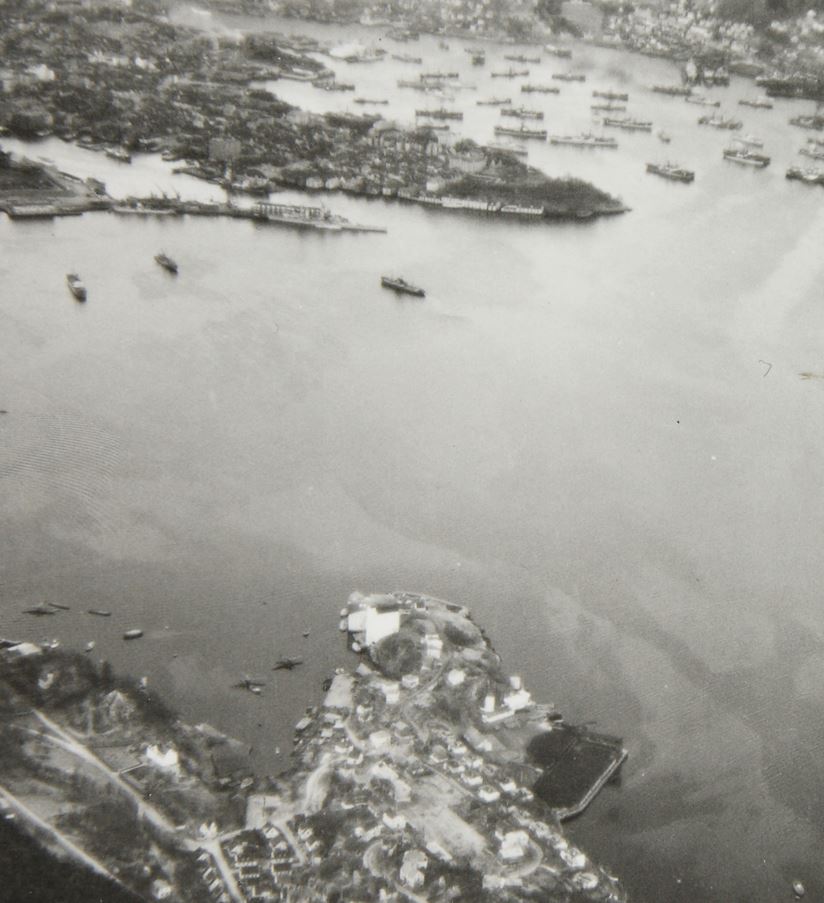
Only 30 minutes before the Skuas arrived a Coastal Command Hudson circled Bergen harbour (the German defences misidentified it as a Heinkel He111) and took this remarkable picture. At the top of the picture, in Puddefjorden, are crowded mostly merchant ships (many from neutral countries, including the US tanker Flying Fish). Then there is the peninsula of Nordnes, then in front of that the Skoltegrunns mole (where modern cruise ships often dock) with the Königsberg alongside. In the foreground is Nyhaven with German Ju 52 floatplanes anchored.
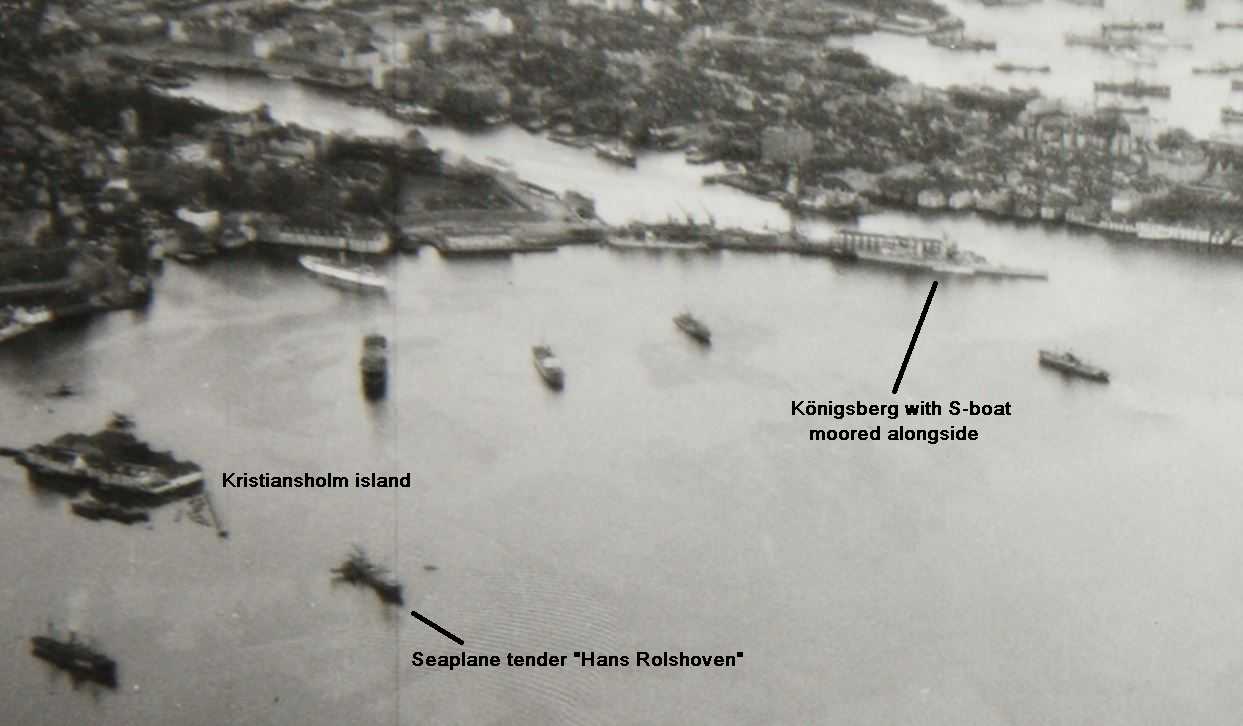
Another view, showing that what looks like a German Schnellboot (S-boat) was moored alongside the Königsberg just prior to the attack. There was apparently an order that two such boats, both damaged in the taking of Bergen, should be positioned to ward of torpedo attacks on the Königsberg. The seaplane tender Hans Rolshoven is just off Kristiansholm island on the right, it seems to have a floatplane near her stern.
800 Squadron provided 5 aircraft and 7 crews while 803 Squadron provided 11 aircraft and 9 crews. At the briefing, the crews were told to fly to neutral Sweden if they did not have enough fuel for the return flight back over the North Sea. The force started taking off at 5 am (British time) on the 10th of April. In the dark, the two squadron formations lost touch with each other during the flight out. One aircraft (piloted by E.W.T. Taylour) lost touch with his formation completely but continued on its own. Flying at 10,000 feet (3048 metres), the two formations made landfall independently some 15 miles (about 25 km) south of Bergen over Korsfjorden (between Håkonsund and Bakkasund). The two main formations arrived over Bergen about 7.10 (British time), approaching from the south. They broke through a thin layer of cloud and did a quick circuit of the harbour to look for the warships. They found that one of their targets had slipped away in the night, but that the other was tied up alongside the Skoltegrunns mole. The two Skua formations both circled around and attacking out of the sun which had now dawned from behind the peaks of the Floyen and the Ulriken mountains, making their dives from prow to stern at diving angles of between 60 and 70 degrees. Each formation seems to have been unaware of the presence of the other until the last minute but fortuitously 800 Squadron found itself attacking directly after 803 Squadron, giving the Germans no chance to recover. They dropped their 500 lb (227 kg) bombs, most bombs being released between 1,500 to 3,000 foot (457 to 914 metres) above the target, but one aircraft made a second run down to 200 foot (60 metres) before releasing. Of the cruiser's impressive anti-aircraft armoury only two 2cm guns on the prow of the ship opened fire on the Skuas, and they were firing almost blind, into the rising sun, opening fire as the first Skua passed 8,000 feet (2438 metres). The 3.7cm flak batteries amidships of the Königsberg had been destroyed by the Norwegian harbour defences and the heavy 88mm flak guns at the rear of the ship could not be bought to bear to fire forward over the main structure of the ship and the cranes and building on the mole. The front 3.7 cm flak batteries of the Königsberg may also have been obstructed by the ship's structure and the large building on the mole. Flak did, however, come from 2cm guns manned by Kriegsmarine gunners on Kristiansholm island (to the north of the main harbour) and from the nearby seaplane tender Hans Rolshoven. The fire from the seaplane tender probably caused it to be classed as a "flak ship" in the combat reports of some of the Skua pilots. It seems that the very first bomb hit to the Königsberg killed all electrical power on the ship rendering the 88mm guns in their power-operated turrets useless and also making the 3.7 cm guns slow to aim with manual power alone.
The combat reports of the Fleet Air Arm pilots claimed three direct hits amidships of the Königsberg and another near the bow. However German sources suggest that no less than 5 and maybe 6 bombs struck the cruiser with another exploding so close astern as to still do extensive damage. These German reports indicate that a couple of these "hits" may have been bombs that first struck the mole and then bounced sideways through the side of the ship before exploding.
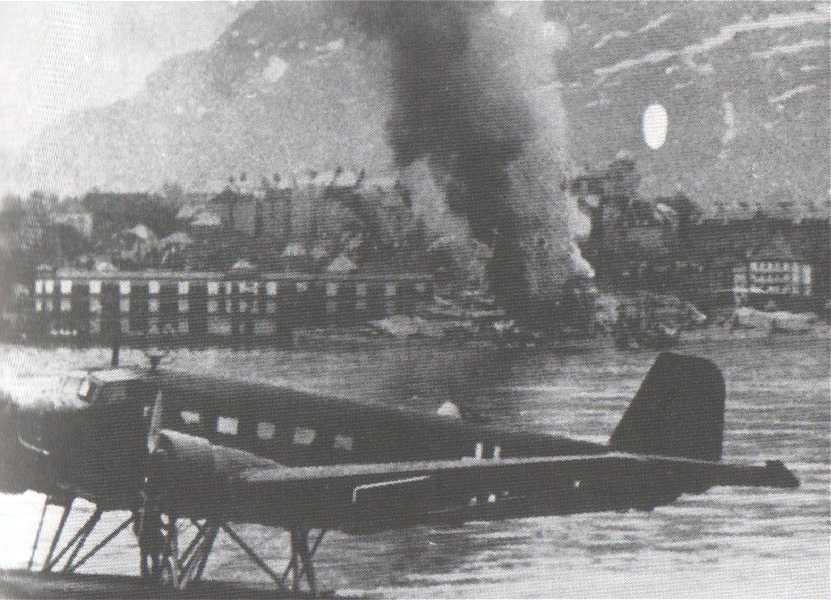
Photographed from the Kristiansholm / Sandviken area. The Königsberg burns and lists to port. In the foreground is a Junkers Ju52 floatplane. German reports list a Ju52 of KGrabV.108 as being destroyed by bombing during the raid (no claim for such was reported by any of the Royal Navy crews). The Königsberg's Arado Ar196 spotter plane was also damaged beyond repair when the cruiser sank.
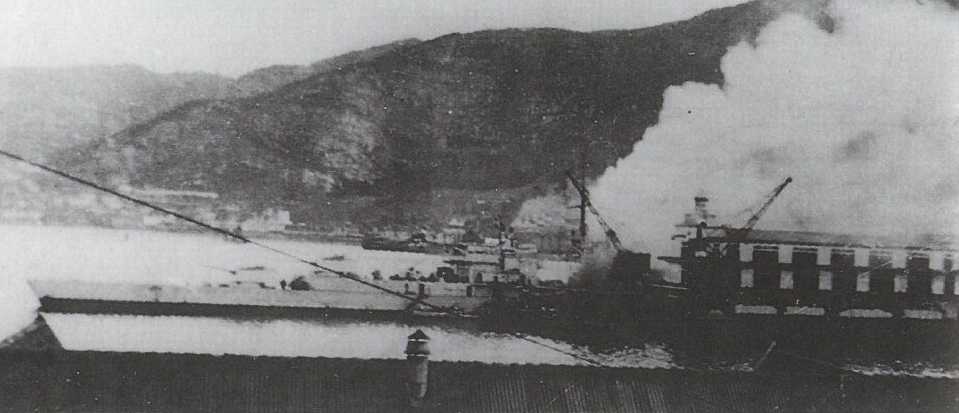
Photographed from the other side (from Nordnes) the Königsberg burns while the crew struggle to save her.
As the aircraft recovered from their dives they raced across the harbour at low-level and some took the opportunity to machine-gun German motor-launches. The Skua, piloted by Edward W.T. Taylour, that had become separated arrived over the target after the others but carried out an attack nevertheless. By this time the Königsberg was sinking by the bows with flames rising from her. The damage caused by the bombs did not sink the ship directly, rather it was the inability of her crew to control the fires without the equipment damaged by the Norwegian shore batteries. Flooding caused by the bombing could not be controlled because the Königsberg's pumps were out of action due to the loss of electrical power. Magazines had to be deliberately flooded to stop the threat of fire reaching them. If the Köln had remained in harbour it is possible her fire fighting equipment and pumps could have saved the Königsberg which finally turned onto her port side (away from the mole) and sank some 2 hrs 45 mins after the Skua attack, only after a brave fight by her crew to save her. A small portion of the Königsberg's stern was left protruding from the water. 18 of the crew were killed and 23 injured in the bombing attack (3 crewmen had been killed and 18 wounded by the Norwegian coastal defence guns on the 8th April).

This dramatic sequence of photos shows the Königsberg on fire and sinking. The photos are courtesy of Ketil Svendsen.
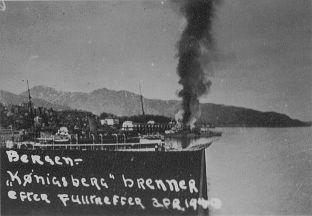
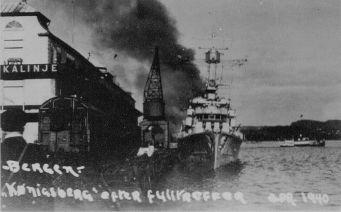
The 2 photos above are courtesy of Michael Hart who's mother lived in Bergen during WWII. On the left of the bottom photo you can see "Den Norske Amerikalinje" (Norwegian-American Shipping Line) building. It would seem that the S-boat moored alongside the Königsberg moved away shortly before or during the air attack.
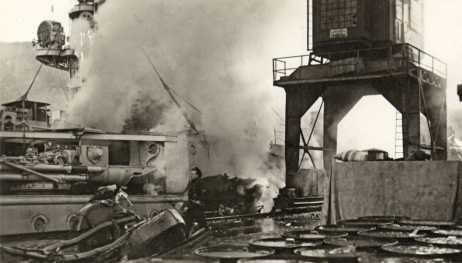
This dramatic photo, courtesy of Geirr Haarr shows a gaping hole in the side of the Königsberg (just behind the figure in the middle of the picture) The photo is featured in Geirr Haarr's book "The German Invasion of Norway".
Ten minutes into the return flight, one of the Skuas went into a vertical dive and crashed into the sea under full power, killing the leader of 803 Squadron's third section. Lt Bryan John Smeeton, and his crewman Mid (A) Fred Watkinson. It seems either Smeeton had been wounded in the attack and collapsed, or the aircraft had suffered some damage to the controls which had given way. All the other aircraft made it back to their base on the Orkneys, landing about 9.45 am. Two Skuas had holes shot in their wings by the 2cm flak but were easily repairable.

This photo is highly likely to show the damage to Skua L2905 flown by Lt William Church. He reported "One large hole in the main plane, close to the fuselage". Lt Church did not released his bomb on his first diving attack, he took his Skua back up to a higher altitude and made a second attack.
Although the Skua pilots were sure they had done major damage to the ship they had not seen her sink. Later reconnaissance flights showed what looked like her stern protruding from the water but this was still not positive proof that the Skuas had sunk a major German warship. Even when it became clear from neutral sources that a cruiser had been sunk it was still not clear which cruiser. Fearful of repeating the German's huge propaganda blunder, when they claimed to have sunk the Ark Royal earlier in the war, the British did not seek to publicise the triumph of the Skua crews. This is a shame since they had scored a notable first: The first sinking of a major German warship in WW2 by aerial bombing and the biggest ship lost to wartime dive-bombing up to that time. It should be noted that the Königsberg was not the first warship sunk by dive- bombing in the war, two Polish Destroyers had been sunk by dive-bombing on the 3rd September 1939 and the Royal Navy destroyer HMS Gurkha was sunk by German dive-bombers on the day before the Königsberg was sunk. For all the men and machines RAF Bomber Command lost trying to sink units of the German fleet in the first months of the war it is ironic that such a victory should be achieved for the loss of a single aircraft and crew using a method (dive-bombing) that was derided by the RAF establishment.

The Königsberg's Arado 196 Spotter plane: recovered from the depths, its underside eaten away by the fire that engulfed the ship. It is standing in front of the burnt-out shell of the "Den Norske Amerikalinje" (Norwegian American Shipping Line) building on the Skoltegrunns mole in Bergen. The building had been gutted by fire and had its roof and top floor destroyed by the explosion and fire that sank the SS Bärenfels. The Arado was coded T3+HH and one source speculates it had the works serial number 1960034 on the tail. It may be that the surviving parts of the Arado were shipped up to Trondheim to be put aboard the German battleship Gneisenau as spares for its own aircraft, before the Gneisenau returned to Germany at the end of July 1940.
If using a phone or tablet these tables are best viewed in "Landscape" mode.
First wave, 803 Squadron
Second wave, 800 Squadron
The Follow-up Skua Strike on the Bärenfels
First wave, 803 Squadron
Second wave, 800 Squadron
The Follow-up Skua Strike on the Bärenfels
The Transport ship Bärenfels was a German supply ship, originally destined for Narvik that diverted to Bergen. It was heavily damaged before unloading on 14th April. It was moored on the Skoltegrunns Mole, on the opposite side to the wreck of the Königsberg. This raid was by only 3 Skuas of 803 Squadron led by Lt Lucy who dropped the bomb which did the damage to Bärenfels. It struck petrol containers on the mole alongside the ship and these detonated and holed her side. This set off ammunition in the aft cargo hold which went off in a series of explosions that sank the aft end of the ship and did extensive damage around the harbour, including gutting the Norwegian-American shipping line building on the mole. The stern of the Bärenfels was submerged but the front remained afloat and the contents of the forward hold were salvaged, including some 10.5 cm flak guns. Click here to read about the fate of the Bärenfels.
The Bärenfels was not the last ship to be sunk in Bergen harbour by Skuas; a raid on the 9th of May 1940 sank the minesweeper M134 (see details at this link ).
The Bärenfels was not the last ship to be sunk in Bergen harbour by Skuas; a raid on the 9th of May 1940 sank the minesweeper M134 (see details at this link ).
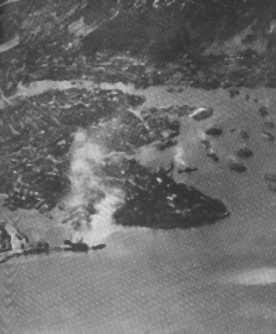
This picture, from a wartime pamphlet on Bomber Command, shows the SS Bärenfels ablaze alongside the Skoltegrunns mole, on the opposite side to where the Königsberg was attacked. The stern of the Königsberg is still just visible above the water.
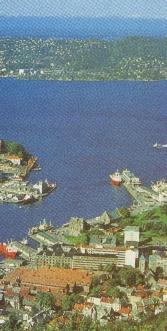
Bergen Harbour
Click for a full panorama of modern Bergen harbour
Surrounded by 7 mountains, the harbour formed the spectacular backdrop to the sinking of the Königsberg. The Skoltegrunns mole can be seen in this picture and the Königsberg was tied up alongside (on the other side to the ship with red hull and white top you can see in the picture) with her bows pointing towards the camera. The Skuas circled the harbour and then report making their dives from bow to stern. Normal Skua dive-bombing procedure at the time was to fly over the target and when the target appeared behind the wing pull up and flick over into a dive. The Skua would end up diving on the target from the opposite direction that it had just flown over it. The two large grey looking buildings between the harbour and the green area in the right foreground are Hakon's Hall (nearest the mole) and Rozenkrantz tower. Hakon's Hall dates back to 1247 and was the Royal palace when Bergen was the political centre of Norway at that time. Rosenkrantz tower was built in the 1560s. Bottom left is the Bryggen, a maze of old wooden buildings, now listed by UNESCO as a World Heritage Site.
Unexploded bomb
In March 2020, building work on the Skoltegrunns Mole revealed an unexploded 500 lb (227 kg) semi-armour-piercing (SAP) bomb. This bomb is likely to have been dropped by Skuas, either when attacking the Königsberg or in the attack on the Bärenfels. The bomb was detonated in the fjord close to Kvarvan fort which had scored hits on the Königsberg when it entered the harbour. Note that only 18% of the weight of a SAP bomb was made up of actual explosive, the bulk of the weight of the bomb was the thick metal casing to enable it to punch through the armour of a warship, hence the bomb itself was rated as only some 100 lb (45 kg) of TNT explosive.
Report of the Unexploded bomb on the Norway-Today website (in English).
Link to Bergen News report (in Norwegian) on the discovery of the bomb.
Link to video of the bomb being detonated.
The Königsberg
The full story of the German Light Cruiser Force is well told in "German Light Cruisers of World War Two" by Gerhard Koop and Klaus-Peter Schmolke ISBN 1-85367-485-0. Albeit some of the details about the sinking of the Königsberg have been overtaken by more recent research by Geirr Haarr.

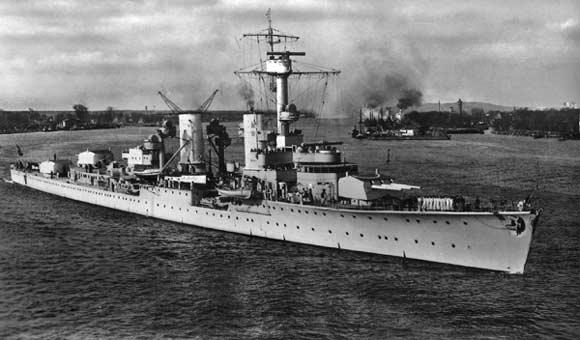
Link to Bergen News report (in Norwegian) on the discovery of the bomb.
Link to video of the bomb being detonated.
The Königsberg
The full story of the German Light Cruiser Force is well told in "German Light Cruisers of World War Two" by Gerhard Koop and Klaus-Peter Schmolke ISBN 1-85367-485-0. Albeit some of the details about the sinking of the Königsberg have been overtaken by more recent research by Geirr Haarr.


Laid down in 1926 the Königsberg was the first in a class of light cruisers (the others in the class were the Karlsruhe and the Köln). Mounting three turrets each containing three 5.9-inch (15cm) guns, she had the unusual German light cruiser layout in that two of the turrets faced to the rear. They were intended to scout ahead of the main German fleet and then either run away from superior forces or draw them onto the guns of the main fleet (German experience at the Battle of Jutland clearly influencing their role) so such a heavy armament facing aft made eminent sense. She had a secondary armament of six 3.5 inch (88mm) and eight 3.7 cm guns along with four 2cm cannon, a formidable anti-aircraft capability for that period. With only 40mm deck armour the Königsberg was vulnerable to the 500lb bombs carried by Skuas. In the open sea, its manoeuvrability would have made it a difficult target. She also carried twelve 21 inch torpedoes. She could carry two Arado 196 floatplanes; one mounted on the catapult, the other dismantled and stored below deck. For the attack on Bergen only one Arado was carried.
Powered by twin steam turbines but also with twin diesel engines for cruising efficiency the Königsberg had a top speed of 32.5 Knots and a range of some 3,000 nautical miles. Built to exploit the terms of the Versailles Treaty,² the Königsberg class of cruiser was considered unsuited for extended periods on the high seas, the savings in structural weight to meet the terms of the treaty, making them somewhat prone to storm damage. Nevertheless, their speed and armament were well up to the standards of the time and with a complement of 820 crew, these cruisers formed a potent part of the Kreigsmarine.
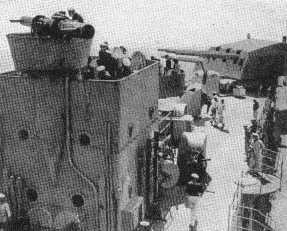
The aft range-finding station and the two rear turrets of the Königsberg. The rear turrets were each slightly offset from the centre line of the ship, an unusual feature of the German light cruisers. This picture shows its early heavy anti-aircraft gun armament of single 88mm gun mountings. By the start of the war, these had been replaced by three twin mountings.
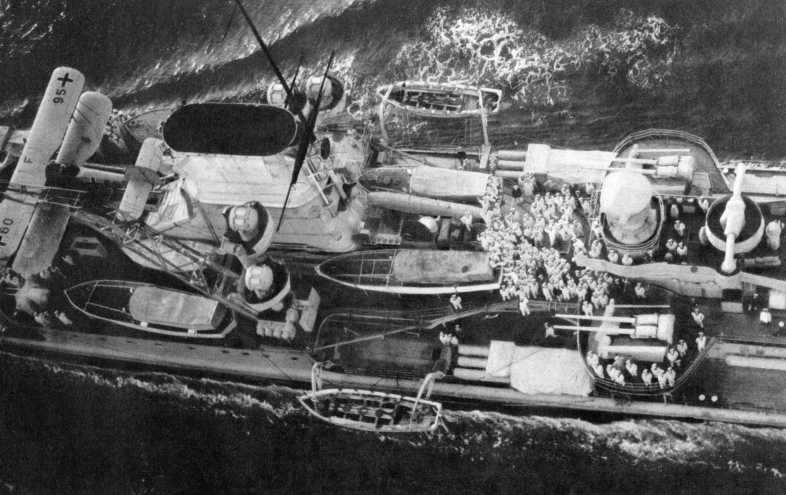
Not the Königsberg, this is a photo of her sister ship the Köln with its deck crowded with sailors, taken by an RAF aircraft in the summer of 1939 when it sailed through the English Channel to take part in exercises in the Atlantic. It shows a layout very similar to the Königsberg with twin 88mm gun mountings, torpedo tubes and a seaplane mounted on a catapult.
The Königsberg was used for minelaying in the North Sea and Baltic patrols during the period of the phoney war. Along with the Karlsruhe and the Köln, the Königsberg found itself committed to the Norwegian invasion. For the operation she had the tops of her turrets painted yellow and a large swastika flag spread across her foredeck, over the anchor chains, to aid identification by the Luftwaffe. Along with its sister ship the Köln, it overpowered the defences of Bergen but was damaged in the process, stopping her leaving with the Köln when the air raids of the 9th April made it plain they had been spotted by the RAF. Hence she found herself on the end of the Skua attack at dawn the following day which sank her. At first, she lay with her upturned stern protruding from the water but a later photograph suggests she may subsequently have become completely submerged.
On the same day as the sinking of the Königsberg her sister ship, the Karlsruhe was torpedoed by the British submarine HMS Truant off Kristiansund. This left the Germans with only three remaining battle-worthy light cruisers, the Köln, Nürnberg and Emden. The German cruiser force would have provided a large part of the naval forces needed to carry out operation Sealion, the planned invasion of Britain in 1940. The loss of so many cruisers and destroyers of the Kriegsmarine in the Norwegian campaign meant that such an operation had little chance of success if the Luftwaffe could not guarantee to keep the Royal Navy at bay for the many days it would take to build up a bridgehead on the south coast of England.
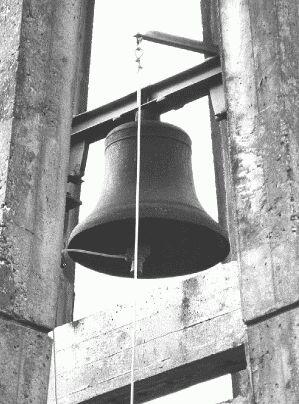

The recovered ship's bell of the Königsberg and a plaque made to commemorate the sinking, photos courtesy of (and copyright of) Torstein Saksvik.
In 1941, Königsberg was refloated and, although still capsized, was towed about 1 km north to Heggernes (Nyhavn). Later in the war, she was towed back to Laksevaag (on the south side of Bergen harbour) and was put back onto her keel. However, there was a major leak and she could only be kept afloat with a salvage vessel alongside continually pumping her out. Therefore Königsberg was put into the floating dock at Laksevag, but when the dock was raised the wreck retained water and the extra weight, distributed unevenly, caused the ship to fall over on to one side making the whole dock list by 11-13 degrees and causing huge damage to the dock structure. So Königsberg was quickly patched up and put back into the sea. She remained at Lasksevaag until February 1945 when she was towed north to the Herdlafiord and put into a small bay called Berlandsundet, on the east side of Askøy. Here the Königsberg was allowed to sink in shallow water and she rested on her side. After the war, the Königsberg was raised again by a Norwegian salvage company and on the 14th or 15th September 1945 started to be towed to Stavanger, on the way there were major problems with leaks. At Stavanger, the wreck was cut up for scrap by 1947.
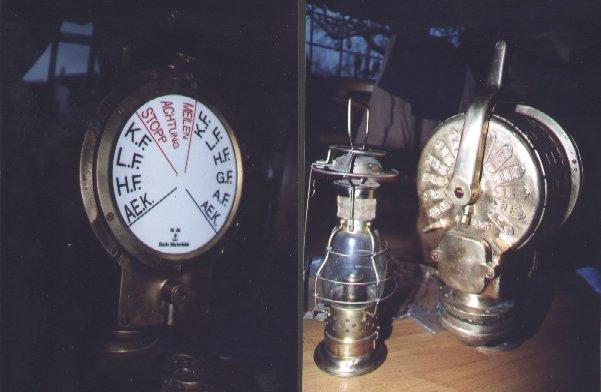
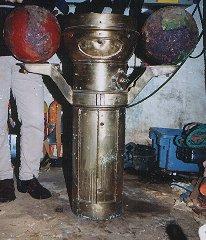
Above: instruments recovered from the Königsberg. Pictures courtesy of Torstein Saksvik.

This is a picture taken during March 2003 of an ashtray from the Königsberg found by a diver in 1945 at the site where she was originally sunk in 1940. The letters K..eyzer Ko.nigsberg are legible. Use of non-Gothic script may indicate it was made before 1933. The item measures around 8x8 cm. Photo and information courtesy of Torstein Saksvik.
The fate of the Bärenfels
The transport ship Bärenfels, which had been very badly damaged by the raid by three Skuas led by Lt Lucy on the 14th April 1940, was refloated in August and then patched up in Bergen's floating dock before being towed to Oslo in November for full repairs, which took over a year to complete. She entered service again at the end of 1941. Exactly 4 years to the day after the ship had first been sunk the Bärenfels was again sunk in Bergen harbour, this time by mines placed by the Royal Navy midget submarine X24. The Bärenfels had not been the target of the attack, which was aimed at sinking the floating dock at Laksevaag, but the submariners confused the large hull of the Bärenfels with their target. The Bärenfels was almost completely submerged after this attack. Later that year (September 1944) there was another attempt to blow up the floating dock by the same midget submarine, this time the attack got its target (and two small vessels moored to the dock when it sank) but with the sad loss of 17 Norwegian workers. The workers were there carrying out repairs to the dock caused by the damage done when raising the Königsberg, the repairs had taken 6-8 months. The dock was completely sunk by the limpet mine attack and was out of action until 1953-54.
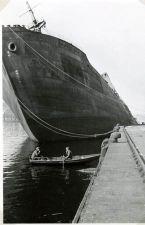
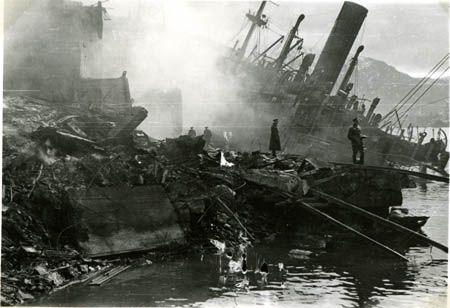
Two remarkable photos of the wrecked Bräenfels after the Skua attack, courtesy of Torstein Saksvik.
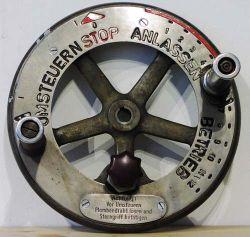
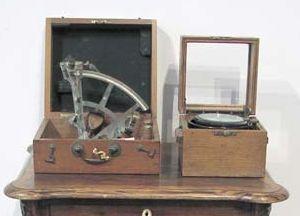
A control wheel and instruments salvaged from the Bärenfels, courtesy of Torstein Saksvik.
NOTES
¹ Casualties to the crew of the Köln caused by British bombers on the 9th April are mentioned in "German Light Cruisers of World War II" by Gerhard Koop and Klaus-Peter Schmolke, but there are no details. I had to wait until seeing the chapter on the capture of Bergen in Geirr H Haarr's book "The German Invasion of Norway April 1940" to find out that the casualties were caused by machine gun fire.
² For some reason, lots of descriptions of the Königsberg, attribute the weight-saving measures used in her construction to limitations set by the Washington Naval Treaty. However, Germany was not involved in the Washington treaty; the limitations on the tonnage of light cruisers was set by the Versailles Treaty.
² For some reason, lots of descriptions of the Königsberg, attribute the weight-saving measures used in her construction to limitations set by the Washington Naval Treaty. However, Germany was not involved in the Washington treaty; the limitations on the tonnage of light cruisers was set by the Versailles Treaty.
LINKS
WW2 Cruiser operations - Includes details and photos of the Königsberg.
A Norwegian Campaign Overview
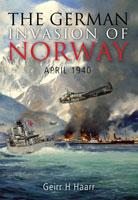
Geirr Haarr's book "The German Invasion of Norway April 1940" covers the seizure of Bergen in fantastic and unprecedented detail.
SOURCES
A full list of sources and bibliography at <this link>.
